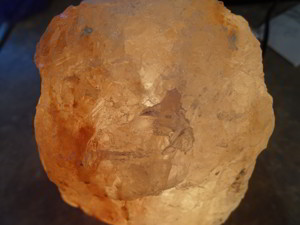Salt Lamp for ADHD? It May Be More Pleasant Than Helpful

Have you read about the supposed benefits of salt lamps for ADHD symptoms? With a warm glow and the promise of helping to improve one’s health, Himalayan or pink salt lamps are very popular. Aficionados tout claims of an improved general sense of well-being, including helping to decrease the symptoms of some mental health conditions. But do any of those claims hold up?
What are salt lamps?
Salt lamps are large crystals of rock salt, often gathered from a source in the Himalayan Mountains or other sources of ancient sea salt from deep in the ground, including the Western United States. They are typically shades of pink from the minerals and other deposits within the salt. To make a lamp, a chamber is carved to insert either a candle or a small light fixture and bulb; the heat from those sources warms the salt, causing it to glow. They come in various sizes and are often used as accent pieces.
Salt’s nature is to attract moisture, especially when warmed. It also has some antiseptic qualities. It could be argued that those two actors might serve to attract moist air and act as an air purifier, eliminating some impurities, allergens, and odors. However, the effects on air quality would be minimal.
The claim:
Some people believe salt lamps also release negative ions that have the ability to improve focus and concentration for the people nearby. Based on that idea, there have been claims in some blogs and other publications that a salt lamp will help to decrease the symptoms of ADHD.
The research:
There is little scientific research on how the presence of a warm salt lamp might affect the symptoms of ADHD. Research has looked at the impact of negative ions, generated by a machine for that purpose, on depression and Seasonal Affective Disorder but it has not examined salt lamp-generated ions and ADHD symptoms.
Columbia University Medical Center’s Department of Psychiatry asked one of its experts about the benefits of salt lamps on improving a person’s mental health.
“There’s no evidence for it,” says Michael Terman, PhD, a professor of Clinical Psychology. “The ions emitted by activated salt are completely different from the negative air ions from a clinically tested apparatus that produces superoxide, and which may act via enhanced blood oxygenation. In Columbia University clinical trials, high-density negative air ionization produced an antidepressant effect far superior to low-density ionization (the latter being typical of home air purifiers).”
When negative ions have had a positive effect on mood, it has been in a controlled clinical situation using precision machinery to generate negative ions:
Air ions and mood outcomes: a review and meta-analysis. A literature review of 80 years of media and scientific literature on the psychological and mental health effects from ions in the air. ADHD is not specifically identified in the study, but the effects of negative ions on depression, anxiety, mood states, and subjective feelings of mental well-being were evaluated. Researchers concluded there was not any “consistent influence of positive or negative air ionization on anxiety, mood, relaxation, sleep, and personal comfort measures that was observed. Negative air ionization was associated with lower depression scores particularly at the highest exposure level. Future research is needed to evaluate the biological plausibility of this association.”
The conclusion:
- Research during the past 80 years has not seen consistent results in experiments that ions use to alleviate symptoms. Without consistency, researchers are unable to know if ions conclusively have an improvement on mental health.
Salt lamps can add beauty to a room and the soft glow could help some people feel more at ease. Given the lack of research available on the health benefits of salt lamps, and that the research on generated ions for mental health has seen limited benefit for depression, salt lamps may not be helpful in addressing the symptoms of ADHD and cannot be suggested as a complementary intervention.
You can find more research on this topic and other topics related to ADHD in our ADHD Research Library. Learn more about CHADD’s Levels of Evidence for ADHD Interventions.
Do you enjoy the glow of a salt lamp? Share your experience with our community.
Pink salt lamps are very popular recently. Some people think they could help improve focus and concentration. But can they actually help with these symptoms of ADHD? Keep reading for what we found out.
